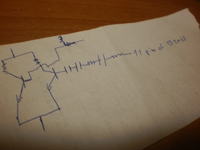aquabard
Newbie level 4

- Joined
- Dec 6, 2012
- Messages
- 7
- Helped
- 0
- Reputation
- 0
- Reaction score
- 0
- Trophy points
- 1,281
- Activity points
- 1,352
Hello all,
I am trying to configure how the magnetic audio head works. Unfortunately I haven't been able to find a datasheet for any magnetic audio head.
In short this is what I want to do. I have an old tape and cd player. What I want is to "replace" the signal from the tape with an audio-in.
To do this I dismantled the player and I see two cable going to the main board from the tape. The first comes from the buttons(play, rec etc) and controls as I see it the movemen of the dc motor. The second comes from the magnetic audio head( part number "ms 15raa2"). But I do not know what these cables are for. Does anyone have an idea?
Thank you all in advance,
Aquabard
I am trying to configure how the magnetic audio head works. Unfortunately I haven't been able to find a datasheet for any magnetic audio head.
In short this is what I want to do. I have an old tape and cd player. What I want is to "replace" the signal from the tape with an audio-in.
To do this I dismantled the player and I see two cable going to the main board from the tape. The first comes from the buttons(play, rec etc) and controls as I see it the movemen of the dc motor. The second comes from the magnetic audio head( part number "ms 15raa2"). But I do not know what these cables are for. Does anyone have an idea?
Thank you all in advance,
Aquabard






